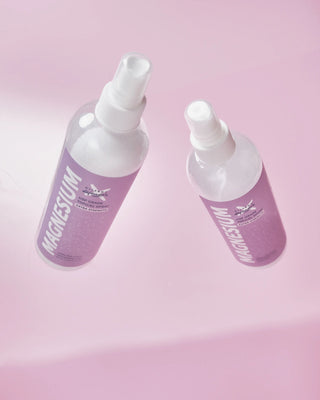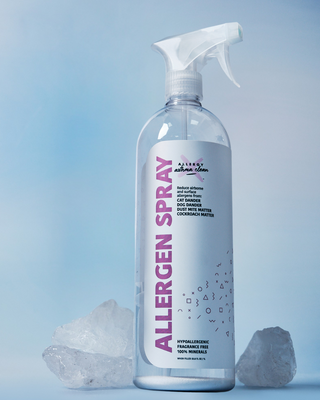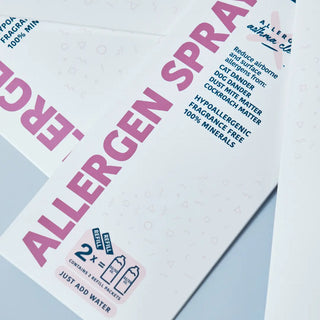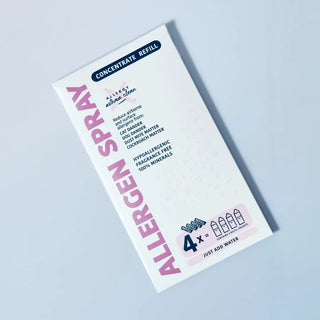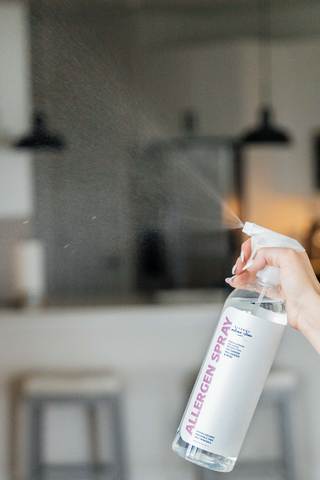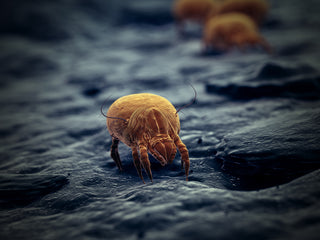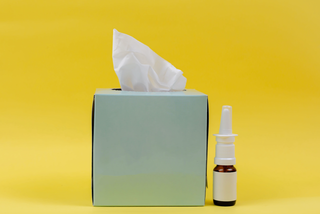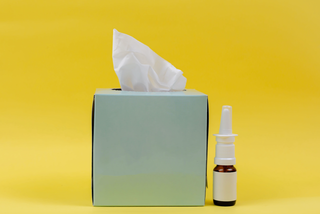Dust mites are microscopic arachnids living in your bed that affect 20 million Americans through allergic reactions to their waste particles and body fragments. Common symptoms include sneezing (especially upon waking), coughing at night or morning, watery itchy eyes, nasal congestion, skin irritation/rashes, and in severe cases, difficulty breathing or asthma attacks. Prevention strategies include investing in hypoallergenic bedding with dust mite-proof covers (less than 10 micrometers pore size), washing bedding weekly in hot water, vacuuming mattresses monthly with HEPA filters, reducing humidity below 50%, avoiding carpeting, and using Allergy Asthma Clean Allergen Spray by Allergy Defender to control airborne and surface dust mite allergens on mattresses, couches, pillows, and carpeting.
Key Takeaways:
- Dust mites thrive in warm, humid beds – These invisible arachnids breed in bedding, and their waste particles/body fragments trigger allergic reactions, not the mites themselves
- Six key allergy symptoms – Frequent sneezing (especially upon waking), coughing (worse at night/morning), watery itchy eyes, stuffy/runny nose, skin rashes/itching, and difficulty breathing or asthma attacks in severe cases
- Signs of dust mite infestation – Waking with itchy/irritated skin and small red bumps on body areas contacting bedding indicate allergic reactions to dust mite waste
- Prevention through bedding choices – Use hypoallergenic pillows/mattress protectors/sheets, wash bedding weekly in hot water, vacuum mattress monthly with HEPA filter, and encase mattresses/pillows in tightly woven covers (under 10 micrometers pore size)
- Environmental control reduces populations – Keep bedroom humidity below 50% with dehumidifiers, avoid carpeting (choose hardwood/tile), minimize stuffed toys (wash in hot water or freeze 24 hours), and keep rooms clutter-free
- Regular cleaning routines essential – Vacuum bedroom weekly (especially corners/baseboards), dust surfaces with damp cloth, wash curtains/blinds regularly, and clean/replace air filters to prevent airborne circulation
- Natural remedies provide relief – Allergy Asthma Clean Allergen Spray by Allergy Defender controls airborne and surface dust mite allergens (100% mineral ingredients, no harsh chemicals), steam cleaning kills mites, and frequent ventilation reduces humidity
- Seek professional help for severe cases – If symptoms persist despite preventive measures, allergists can prescribe antihistamines, nasal sprays, or immunotherapy (allergy shots) for effective management
Are you aware there are microscopic creatures that quietly reside in your bed? And that you can be coughing, sneezing or have watery eyes because of them? What are they you ask? Dust mites. In this article, we will unveil the invisible world of dust mites and explore the sneaky symptoms they can cause.
Dust mites are arachnids that thrive in warm and humid environments, making your bed an ideal breeding ground for them. While they are practically impossible to see with the naked eye, the effects of their presence can be hard to ignore. Dust mite allergies, if you have them (20 million Americans do), can trigger a range of symptoms, from dificulty breathing, to sneezing, coughing, and watery eyes for some individuals.
Understanding the signs of a dust mite allergy is pretty darned important if you're trying to prevent those bothersome allergies. From investing in hypoallergenic bedding to regularly cleaning your mattress and pillows, there are steps you can take to minimize the impact of dust mites on your breathing and your health.
Stay tuned as we dive deeper into the world of dust mites, uncover their hidden symptoms, and share practical tips for keeping them at bay.
The Most Common Dust Mite Allergy Symptoms Include:
- Sneezing: Dust mites can trigger frequent sneezing, particularly upon waking up or when in close proximity to your bed.
- Coughing: If you find yourself coughing more often, especially at night or in the morning, it could be a sign of a dust mite allergy.
- Watery eyes: Dust mite allergies can cause itchy and watery eyes, making it difficult to focus and cause discomfort.
- Nasal congestion: Many individuals with dust mite allergies experience a stuffy or runny nose, often leading to difficulty breathing through the nose.
- Skin irritation: Some people may develop a rash or experience itching due to their dust mite allergy. This does not sound pleasant!
- Difficulty breathing: In severe cases, dust mite allergies can trigger asthma attacks or difficulty breathing, requiring immediate medical attention.
If you experience these symptoms regularly, especially when you are in bed or have just woken up, please consider you just might be allergic to dust mites.
Identifying Dust Mite Infestations in Your Bed
While dust mites themselves are invisible to the naked eye, there are signs that can indicate their presence in your bed.
One common indicator of a dust mite infestation is waking up with itchy or irritated skin. This can be a result of an allergic reaction to the mites' waste particles. Additionally, if you notice small red bumps on your body, particularly in areas that come into contact with your bedding, it could be a sign of dust mite allergy.
Tips for Preventing and Reducing Dust Mite Populations
Preventing dust mite infestations and reducing their populations in your bed is essential to manage dust mite allergies. Here are some practical tips to help you keep dust mites at bay:
- Invest in hypoallergenic bedding: Opt for hypoallergenic pillows, mattress protectors, and sheets that are specifically designed to repel dust mites.
- Wash bedding regularly: Wash your sheets, pillowcases, and blankets at least once a week in hot water to kill dust mites and remove their allergenic particles.
- Vacuum your mattress: Use a vacuum cleaner with a HEPA filter to regularly clean your mattress, removing any dust mites or their waste particles. How often should you vacuum your mattress? Monthly.
- Reduce humidity: Dust mites thrive in humid environments, so use a dehumidifier or air conditioner to keep the humidity levels in your bedroom below 50%.
- Avoid carpeting: If possible, avoid having carpets or rugs in your bedroom as they can harbor dust mites. Opt for hardwood or tiled floors instead.
- Avoid stuffed toys: Minimize the number of stuffed toys on your bed as they can also harbor dust mites. If you must have them, wash them regularly in hot water. Or throw them in the freezer for 24 hours.
You can significantly reduce the dust mite population in your bed and alleviate the symptoms of dust mite allergies if you follow these ideas.
Effective Cleaning and Maintenance Routines for Dust Mite Control
In addition to the preventive measures mentioned above, establishing a regular cleaning and maintenance routine can further help in controlling dust mite populations in your bedroom. Here are some effective practices to consider:
- Vacuum your bedroom: Regularly vacuum your bedroom, paying extra attention to areas where dust tends to accumulate, such as corners, baseboards, and under furniture. And if you have hardwood flooring or tile, wash the floors.
- Dust surfaces: Use a damp cloth to regularly dust surfaces in your bedroom, including furniture, shelves, and window sills.
- Wash curtains and blinds: Dust mites can also settle on curtains and blinds, so make sure to wash them regularly or opt for dust-resistant window coverings.
- Keep your bedroom clutter-free: Dust collects everywhere and it's tough to dust especially on cluttered surfaces, so keep your bedroom tidy and organized to minimize dust mite populations. De-clutter if you must!
- Regularly clean air filters: Dust mites can circulate in the air, so make sure to clean or replace your air filters regularly to keep the dust mite population down.
By incorporating these cleaning and maintenance practices into a routine, you can create a home that is less hospitable to dust mites and reduce the risk of allergic reactions.
Dust Mite-Proof Bedding and Mattress Covers
To further protect yourself from dust mite allergies, consider investing in dust mite-proof bedding and mattress covers. These specially designed covers create a barrier that prevents dust mites from penetrating your mattress and pillows, reducing your exposure to their allergenic particles.
When purchasing dust mite-proof bedding, look for covers that are made of tightly woven fabrics with a pore size of less than 10 micrometers. These covers should encase your mattress and pillows. There are special duvet covers that also offer protection.
Remember to regularly wash the dust mite-proof covers according to the manufacturer's instructions to maintain their effectiveness. By combining dust mite-proof bedding with proper cleaning and maintenance practices, you can create a safe haven in your bed that is free from dust mites and their allergens.
Natural Remedies for Dust Mite Allergies
In addition to preventive measures and cleaning routines, some natural remedies can help alleviate the symptoms of dust mite allergies. While these remedies may not eliminate dust mites entirely, they can provide relief and complement other preventive measures. Here are a few natural remedies to consider:
Allergy Defender's Allergen Spray: Designed to control airborne and surface dust mite matter allergens. Simply spray on the mattress, couch, pillows, carpeting and so much more. Only 100% mineral ingredients. No harsh chemicals.
Steam cleaning: Steam cleaning your carpet can help kill dust mites and remove their allergenic particles. Use a steam cleaner with a high-temperature setting for optimal results.
Frequent ventilation: Open your windows regularly and allow fresh air to circulate in your bedroom. This can help reduce humidity making it less favorable for dust mites. If you live in a high humidity area keep your windows closed. Best to use a de-humidifier.
While these natural remedies can provide relief, it is important to note that they may not be as effective as medical treatments or professional interventions for severe dust mite allergies.
Seeking Professional Help for Severe Dust Mite Infestations
If you have tried various preventive measures and natural remedies without significant improvement in your symptoms, it may be time to seek professional help. A healthcare professional specializing in allergies can help diagnose and manage your dust mite allergy effectively.
In severe cases, your healthcare provider may recommend medications such as antihistamines, nasal sprays, or even immunotherapy (allergy shots) to alleviate your symptoms and reduce your sensitivity to dust mites.
Remember that seeking professional help is essential if your symptoms are severe, persistent, or affecting your quality of life. With the right medical guidance, you can effectively manage your dust mite allergy and enjoy a more comfortable sleep.



